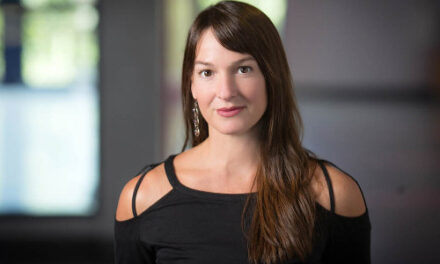Now in its 41st season in Durham (and 85th year altogether), the American Dance Festival continues to offer fresh approaches to the art form. New this summer is Coming Home: ADF Alumni Return, a program of five works by five different choreographers, all former ADF students. They were selected from over 130 entries by a 10-member panel of ADF alumni. The result was a highly satisfying evening of wide-ranging works.
Two pieces were male solos performed by the choreographers. The first, Untitled, was by Burr Johnson, an ADF student from 2006 to 2009 and now a New York City-based dancer/choreographer. Clad in a hooded white leotard decorated with bold black lines, he began in a showy style set to “Gee” by bubblegum pop group, Girls’ Generation. Tall and long-limbed, Johnson moved swiftly around the stage in combinations of gymnastic floor exercises and yoga positions, all filtered through a strikingly limber and lyrical presentation. A middle section, accompanied by whale song, slowed into more sensual moves and angular poses, and then the piece finished by returning to upbeat music and big gestures. Johnson’s impressive balance, well-planned flow and sprinkling of humor made a fine display of his talents.
The other solo came from Los Angeles-based Julio Medina, a student in 2011, and now a touring performer and teacher of hip-hop and modern dance. His I Gotta had breakdance spins and handstands interspersed with workout routines, often accompanied by his own narration. Dressed in knit cap, nylon jacket and track pants, Medina sometimes spoke directly to the audience about his life and at other times impersonated a coach encouraging him to “be number one.” Medina’s street-smart stances included some blatantly sexual moves but there also were introspective moments made strangely affecting by his softly blowing into a sports whistle. Medina’s athleticism impressed but the piece seemed loosely organized and unfinished.
Alex Springer, a 2003 student, is a Brooklyn-based performer and teacher who, since 2008, has been choreographing collaboratively with Xan Burley in a variety of spaces and mediums. Their You being Me being You and the Eye was a piece exploring how bodies react to sounds. At the opening, Springer was wearing a silky one-piece outfit, while Burley was in a shirt and shorts of soft fabric. They moved about the stage as a unit, sometimes mirroring each other but never touching. Their movements were loose-limbed, like broken puppets. To a soundscape by Alexandre Lunsquii, which included low brass instruments blatting and a gravelly voice stretching out low sounds, the pair responded to each minute variation.
Then they took turns, with one being off-stage making various sounds with his or her own voice while the other reacted. After that, they began to dance more closely, holding onto each other, fearfully glancing around them. They then disappeared for a short period and suddenly popped back out, having traded costumes. At that point, they moved off the stage and faced the audience, pointing and gesturing before running up the aisles and out into the lobby. The piece had a curious appeal despite an academic feeling and rather disconnected parts.
The other two presentations were the audience’s favorites. First came TedX on Love, a parody of the popular TED Conferences video talks. Dance and theater choreographer, Raja Feather Kelly (a 2008 student), had three men and three women lined up onstage dressed in everyday clothes, except they each had on different colors of full body stockings that also covered their faces. They began to talk to the audience, ostensibly about the nature of love but admitting that they really knew nothing about it and were just improvising to fill up the time. They gave definitions of love to a musical beat; they danced to Carly Rae Jepsen’s love songs, including “Call Me.” Later, the group pretended to dance out the audience’s projected thoughts of love, then danced to some Philip Glass, and finally sang “Seasons of Love” from Rent. Although more theater than dance, Kelly’s clever sendup and his dancers’ hilariously satirical tone made the piece great fun.
Chafin Seymour‘s Gaze was perfect for the evening’s finale. The Brooklyn-based choreographer, a 2010 student who now has his own dance collective, collaborated with the three dancers in the piece (David Glista, Cameron McKinney, Sean Nederlof). It opened in shadows, with the sound of rain falling as the men were revealed sprawled on the floor. They began struggling to stand, crouching as if afraid of an unseen force and reaching up as if to be freed. A sudden shift turned the gloom into a funny alternate world, the three clowning in silly poses to a pop love song. Then a quick shift and they were back to the gloom, one of them seemingly drugged or injured. The other two ignored him at first, thinking he was okay, but soon they tried to hold him up, the problem then transferring to the others as they collapsed. The final part had them grabbing and tearing at themselves as if infected.
The ominous atmosphere, the clowning and the mysterious characterizations seemed like fresh versions of similar elements in Pilobolus and Paul Taylor’s works – and that’s meant as a compliment. The piece was tightly paced, highly intriguing and faultlessly performed. The prolonged cheering at the curtain call was fully deserved.
For more on the summer’s ADF performances, visit our calendar.












